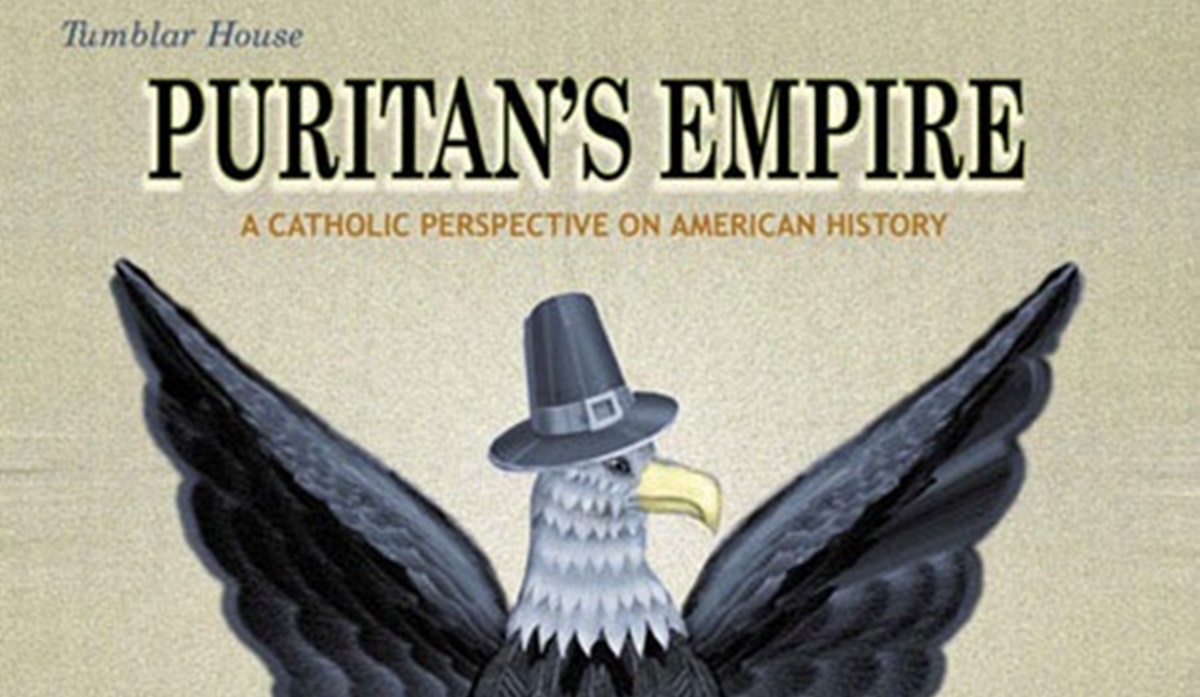Puritan’s Empire
Charles A. Coulombe
Tumblar House
624 pages
$35.95
Puritan’s Empire by Charles A. Coulombe is a unique tour de force of American history from a Catholic high traditionalist perspective, spanning the colonial period to the modern day. Although some sections are dry, the colorful and controversial personal analysis undergirding the volume’s rationale will keep the reader intellectually engaged, regardless of whether or not he agrees with the author’s conclusions.

Mr. Coulombe conveys the notion of sacramental kingship within a Catholic society and the nuances of the class system from days of yore. He emphasizes the nature of noblesse oblige as both a privilege and a responsibility, with each layer of the system integrally bound together through a trickle-down of interconnected duties. This is refreshing, given how modern historical dramas often mangle the social structures of past eras by burdening the past with present perspectives and behavioral norms.
As a royalist sympathizer, Mr. Coulombe sheds light on the plight of monarchists from across the historical timeline. He gives a detailed overview of the Loyalists during the American Revolution, not only covering the individual conditions of the Tories in each of the thirteen colonies, but also highlighting the Catholic support for King George III, as exemplified by the Catholic Scottish settlers in the Mohawk River Valley and the Irish Volunteers from Philadelphia.
Another part of the book worthy of appreciation is the author’s marked enthusiasm for the world of literary achievement. He delves into the major names and artistic movements and explains the natures of the different literary inspirations and how they relate to the historical periods in which they sprang up. His description of the differences between the Age of Reason and the Age of Romanticism in art and culture is particularly intriguing.
Mr. Coulombe covers the many complex motives behind the movers and shakers on both sides of the American Civil War. He portrays Abraham Lincoln as being more concerned about preserving the union than liberating the slaves and highlights the fact that many Southerners who fought in the war never owned slaves. However, his glorification of the agrarian life and Southern aristocracy may strike many mainstream readers the wrong way, given that that society was built upon slave labor and impoverished tenant farmers.
Furthermore, Mr. Coulombe refers to the scorched earth policy of Sherman’s March to the Sea as being “unequaled by anything in the annals of Christian armies.” Readers may have cause to cite the many territorial, dynastic, and religious conflicts carried out in the Old World and the New World to show that Sherman was following a long tradition of making war hell for the rebellious populace.
Another area of note is the way the author covered Queen Isabella of Spain. He puts forward a substantial overview of her achievements and how her legacy affected the history of Christendom and the Age of Discovery. He also defends Isabella’s expulsion of the Jews from Spain. While he does offer analysis appealing to a wider historical context, he then makes a theologically driven argument about non-Catholics being “outside salvation,” which, he indicates, justified Isabella casting them out of their homes in favor of ruling over a purely Catholic kingdom.
He applauds Isabella for not unleashing a Jewish genocide: “[s]he did not desire the death of sinners, but that they should live.” This equates the practice of Judaism with sinful living and insinuates that religious persecution of this type is more acceptable, providing no one is executed. Other references to Christian-Jewish relations raised in the book include the injunction that Christians should send Christmas cards to Jewish acquaintances in an effort to bring about their conversion.
Following this trend, Mr. Coulombe makes reference to Protestants featured in his text as “heretics” and tends to negatively portray most major interreligious dialogue efforts. This includes the efforts of Archbishop John Carroll to assimilate the Catholic community into American life and his failure to do more to convert Benjamin Franklin. Other names to be brought up disparagingly include Cardinal Gibbons and Cardinal Spellman, both pillars of the Church in America. Mr. Coulombe also expresses his view that Archbishop Fulton J. Sheen’s popular TV program Life Is Worth Living did not concentrate enough on converting the nation. The Baltimore Catechism comes under fire as being too “modernist.”
In the last section of the book, Mr. Coulombe inserts Paul Blanshard’s “Catholic Master Plan,” which was originally meant to paint a mocking portrait of Catholic teaching for the benefit of xenophobic Protestant Americans. It was intended to make the Church out to be a theocratic tyranny, bent on suppressing religious freedom, banning secular schooling, forbidding civil divorce and marriages with non-Catholics, etc. However, the author seems to support most of the program outlined by Blanshard, albeit in satire, for Catholicizing America. The author states: “It is precisely the sort of measures Blanshard describes which are required to save the nation from the twin threats of dystopia and bloody anarchy which appear to await us. Obviously, they are the bare minimum; but think on the benefits which could accrue!”
Mr. Coulombe emphasizes the necessity of rejuvenating Catholic culture in America by maintaining liturgical traditions and telling the most treasured stories of the faith. He advocates bringing back the traditional prayers, songs, and customs associated with individual feast days and liturgical seasons. He says Catholics should “keep Advent until Christmas, and Christmas till Epiphany, feast at Carnival and fast during Lent” – all this to enkindle a sense of community with fellow believers celebrating together the glories of the redemption story.
All things considered, Puritan’s Empire proves to be far from dull, and it is certainly capable of sparking up some intriguing debate on the role of faith in American society and beyond. It should be recommended to anyone interested in getting a better understanding of a Catholic Traditionalist worldview, even to outsiders looking in. It is available for purchase at Tumblar House, as are other books by the same author.


